In this article I will show you the shocking data affecting the Spanish Hospitals, in terms of adverse events (EAs), errors in procedures, afectación a la Calidad Asistencial e impacto económico. On the other hand, solution “intelligent” que mejoraría toda esta situación de forma eficiente y eficaz.
INTRODUCTION AND ANALYSIS OF DEPARTURE
The Health should ensure the provision of services in the right place and time, with levels of quality and safety compromised. In 2004 the World Health Organization (WHO) creates the World Alliance for Patient Safety to promote good practice and recommend.
According to the National Study of Adverse Events (EAs) Hospitalisation-Related (ENEAS), the 9,3% of hospitalized patients have any side effects related to health care. A 42,8% of AEs were considered avoidable. In a 63,3% of all EAs in implementing new procedures stated (p.ej. Diagnostic tests) and a 69,9% Additional treatments (p.ej. medication, rehabilitation surgery). The 25% of adverse events in Spanish hospitals are related to problems in performing a procedure, which, half, are the result of an operation. A 19% is due to patient identification. For this reason, described one of the international goals to strengthen patient safety Joint Commission is to improve the accuracy of patient identification. The solution identification and localization using RFID reduces patients EAs with a clear economic benefit and quality of care.
The implementation of the identification and location system is profitable due to the high costs involved in conducting EAs. According ENEAS, occur in Spain 418.000 EAs (9,3% of about 4,5 million revenue / year) which correspond to a mean of 6 days in excess (cost 300 € / day). Additionally the 66,3% performing precise procedures and additional treatments with high costs.
According to the Institute for Drug Use (ISMP) it is estimated that 1,4% of annual hospital admissions suffer errors in medication administration, direct cost is 200 million € uros.
On the other hand in the hospital sector is "lost" A 15% annual asset purchases and other material. This percentage is unsustainable.
Todo ello supone unos costes de más de 2.000 Million € uros. Bearingnote that the 50% are predictable, in Spain there is a potential of about more than 1.000 € million savings.
La implantación del sistema RFID permite a un hospital alcanzar los objetivos de ahorro y calidad asistencial con un retorno de la inversión en menos de un año.
- OBJECTIVES:– Improve the quality of care– Minimize the EAS– Control assets– Reducir costes y optimizar procesos para obtener un beneficio económico
– Provide multiple savings
- SOLUTION:The EPC / RFID is a technological solution applications and coverage for all areas of investment and ensuring the scalability feature. This scalability allows each Hospital or tailor the solution according to their priorities and financial resources to achieve the best results and short-term benefits.EPC (Electronic Product Code): Electronic Product Code, that identifies all items uniquely and unambiguously in the supply chain. A series of bits that identify the manufacturer, product category and product number.RFID RFID (radio frequency identification): method of identifying items using Radio Frequency.WHAT IS THE SOLUTION RFID?
The operation is simple, the label or RFID tag containing identifying data of the object to which it is attached, o bien, Paciente / Health Workforce carrying it in different formats, emits a radio frequency signal with said data, esta señal es captada por un lector RFID el cual lee la información y la pasa en formato digital a la aplicación específica que utiliza RFID.
The system of identification and localization using RFID brings:
- Optimization of care processes by reducing inefficiencies
- Automated quality indicators for improved decisions
- Increasing Patient Safety and Quality Care

- Advantages for the implementation staff
del sistema. “El RFID disminuye el tiempo que se dedica a la gestión para poder emplearlo en el paciente, them the human resources
other activities that create value ". - Advantages for the patient care. The patient benefits but does not perceive. Because what is perceived healthcare, if you are happy or not with how they have treated or if you have solved your problem.
- It also simplifies the administrative process (all online), have a real time inventory, control forfeitures, reduce time in the logistics process, optimize planning and control purchasing costs of the surgical… el personal sanitario en general lo percibe como algo positivo.
Functional diagram of an RFID system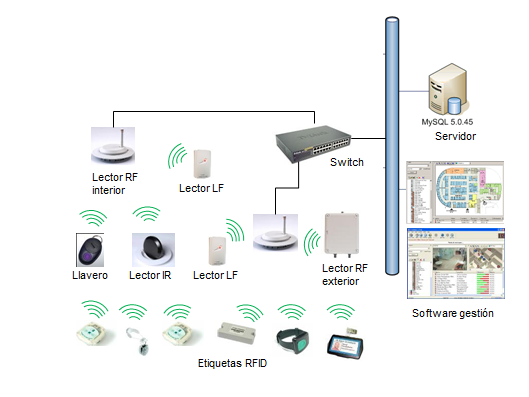
The system monitors all devices, alert when an incident happens and can also interact with physical items such as locks, security camera on light panels.
Where may apply Solutions:
- Asset Tracking and traceability (drugs, prosthesis, quirúrgicos kits, dialysis machines, Wheelchair ...)
- Stock control and inventory in real time.
- Location of medical equipment
- Patient identification location i
- Security for healthcare professionals
- Control of Hand Hygiene
- Monitoring of mothers and infants, etc ...
SURGICAL APPLICATIONS BLOCK
The provision of these services is the most complex health systems.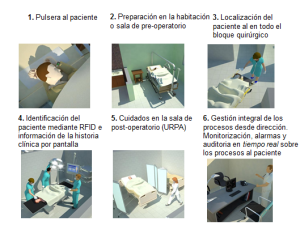
La OMS inició una campaña para la informatización de la lista de verificación quirúrgica con el lema “La cirugía segura salva vidas”.
The RFID integrates personalized for each professional profile with HIS (Hospital Information System) by the set of HL7 international standards for the electronic exchange of health information.
The RFID system integrates different applications-oriented management and verification phases and integrated processes in the surgical block. Turn to automate processes and make them more transparent, thereby helping to prevent errors and improve quality of care, addition to the basic benefits to costs.
The system allows the unambiguous identification of the patient in the surgical area and its location in real time just by placing an RFID bracelet patient (customizable bracelets to wrist or ankle, to carry on your belt or as a pendant).
Assets Control
This system allows real-time location of equipment, inventory automation, retrenchment, maintenance processes, reduction of duplicate facilities and greater efficiency and quality of care.
Placing a tag on RFID tag (a microchip with an antenna) in each of the equipment and, using readers and management software, recorded location data, Use and Maintenance. The reader transmits system information in real-time software so that there is full monitoring equipment and necessary information is collected to improve operational efficiency.
Benefits. Low economic investment: Through continuous monitoring and traceability a clear picture of the use of the equipment is obtained. Hospitals are forced to have excess stock to compensate for the invisibility of its assets, namely, that some of the teams are not detectable or usable, resulting in about unnecessary purchases or replacement of equipment.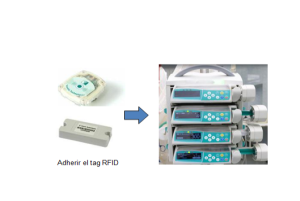
Preventing loss of active: You can keep track of equipment to reduce the high costs of the loss or theft thereof.
Greater efficiency: Eliminating the time spent locating equipment accelerates internal processes and medical staff can focus on activities that add value to the service provided. Studies, up to a third of staff time lost in search vehicles.
Increased safety for patients: The inability to locate an available time critical equipment directly affects the quality of care. The system allows medical personnel to use only those assets perfectly maintained to provide health care to patients.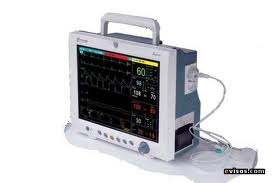
Ease of maintenance management teams: The monitoring of assets and equipment allows us to know the uses of these and schedule efficiently its periodic maintenance. The system
can alarm when a team comes out of a certain area. According to studies
a staggering industry 12 – 15% annual purchases.
DRUG ADMINISTRATION
The RFID system can uniquely identify the patient and easy, mostrándole por pantalla toda la información de la historia clínica y de la prescripción del medicamento, Routes of administration, dose, etc.. reducing human error.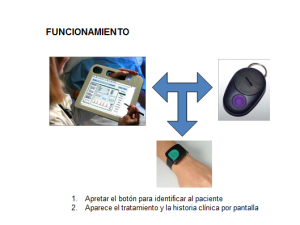
Benefits: Easy identification of the patient that reduces errors in administering medication. Disposition of Patient Health Record on mobile devices through integration (HL7) HIS with hospital or other applications.
The 34% errors are made at the time of administration. However it is estimated that 98% of medication errors in the administration reach the patient; this is because in a system of drug use, errors that occur can be intercepted by personnel involved in the process at later stages. However, the patient has no one to protect you from errors that occur in the administration of medication.
INTELLIGENT CONTROL OF HOSPITAL LOGISTICS
Immediate availability of information about the status of stocks in all peripheral stores.
• Reduced error rate and loss.
• Cost reduction in operations and product consumption.
• Improving operational efficiency and reduced time replenishment processes.
• Increased availability of materials.
• automatic replenishment.
• Increased productivity at both the medical staff and warehouse staff
Carousel Automated Storage Service – Modular Cabinets with ISO files 3394 (60×40) for surgical consumables.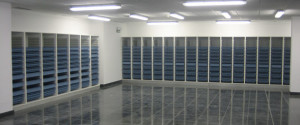
PERSONAL SAFETY FOR HEALTH
Every staff member, identified with its accreditation RFID (buttons, RFID bracelets to pendants) can be identified and located in real time. It is also possible to make other communications via telephone, search, etc..
If patients also carry RFID tags can be configured two tags (medical personnel or patients) they can not come to some meters away.
The system can be integrated in the CCTV. Also on timely reports.
Slew Rate: Thanks to the built-out button, medical personnel can
generate alarms to immediately alert security personnel.
Improved
security: Using the reports generated by the system, The hospital can
analyze alarms produced for assessment and decision making.
MANAGEMENT CONTROL AREA FOR EMERGENCY
It is estimated that in the ER 75,9% of AEs are preventable.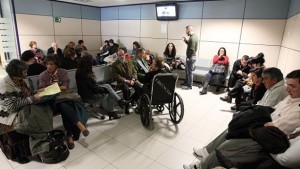
Unique identification and location of real-time patient. Time monitoring of every patient in waiting rooms, boxes and other units as RX. State of the pits (free, busy, closed). Minimize waiting time optimizing resources, control TRIAGE. Information screen waiting for relatives. Automatic access to medical records by mobile devices (Tablet PC, PDAs, cars, etc.) with secure access al HIS.
Parameterization alarm as defined by the hospital rules. Automatic reporting on quality indicators for decision making.
MONITORING OF MOTHERS AND INFANTS
When a pregnant woman is admitted to hospital, is placed a bracelet with a unique identifier, through computer terminals entire delivery area, automatically displays information about her health personnel. The system collects information about the movements of the patient and the time spent in each room. Once the baby is born, is placed on the ankle bracelet designed especially for infants, preventing manipulation except by authorized personnel. Their placement does not interfere with the establishment of the mother-child bond or the usual hygiene procedures performed newborns. Besides this tag, is reusable and its battery provides an average of three years of life.
Doctors and nurses can access the patient's history at all times thanks to automatically Bracelet. The system will alert you if any of the processes to be performed after delivery has not been executed or if events occur not allowed, as the extraction of a newborn in a given area. If necessary, locate the solution enables a neonate or mother.
HAND HYGIENE CONTROL
Infections related to health care (IRAS), occur worldwide and affect hundreds of millions of patients. This causes an increase of morbidity and mortality, and a longer hospital stay and increased economic costs associated.
With the implementation of this solution the hospital automatically monitors compliance with hygiene protocols in moments 1, 4 and 5 corresponding to the action plan established by the WHO "Save lives".
BENEFITS
• Reduction of the IRAS and the costs associated with them.
• Increased compliance with hand hygiene guidelines (WHO).
• Collecting data automatically (objectivity and reliability of data) and report generation facilities or personnel.
• Knowledge of the degree of adherence to the program as health profile
• Monitor the effectiveness of training on hygiene
• Elimination of observation resources.
• Monitoring of compliance with hand hygiene protocols.
• Helps identify the source of infection.
• Monitoring the contents of the bottle or dispenser.
WORK METHODOLOGY, MANAGEMENT AND CONTROL OF QUALITY
Situation Analysis, areas and processes to be implemented to determine the viability.
Process definition and project objectives with the standards to be met. Design and evaluation of infrastructure map of tests to be performed
Concept Testing. Tests defined in both laboratory and field are made, analyze them and configure RFID devices that best suit the project.
Installation and implementation and planned, coordinated and agreed with the Hospital, holder to minimize the impact on the daily tasks of self Hospital.
If you are interested in implementing this system and want to know more, contact with me. If you liked or you think this article may interest someone Share.


Buenos dias,
soy médico preventivista en el hospital de Badajoz (España) y me gustaría que nos proporcionase más información sobre los sistemas de monitorización electronica.
en primer lugar estamos pensando en la higiene de manos de un servicio concreto.
nos interesa saber:
– la necesidad de obras
– tipo de material/productos/sistemas a adquirir
– como se realiza la gestión de ingormación (por el personal de hospital?, empresa externa?)
– se puede re-programar y utilizar para control de higiene de manos en otros servicio o solamente en el instalado como primera opcion
– se utiliza ya en otro centro hospitalario en España
¿podría darnos una aproximación de coste?
Mucha gracias.
Un saludo,
Manuela Skodova
Facultativo especialista de área
Servicio de Medicina Preventiva y Salud Pública
Hospital Infanta Cristina de Badajoz
Estimada Manuela,
Le responderé encantado a todas sus preguntas y le enviaré la información a su correo.
Gracias por su interés.
Ferran Ruiz